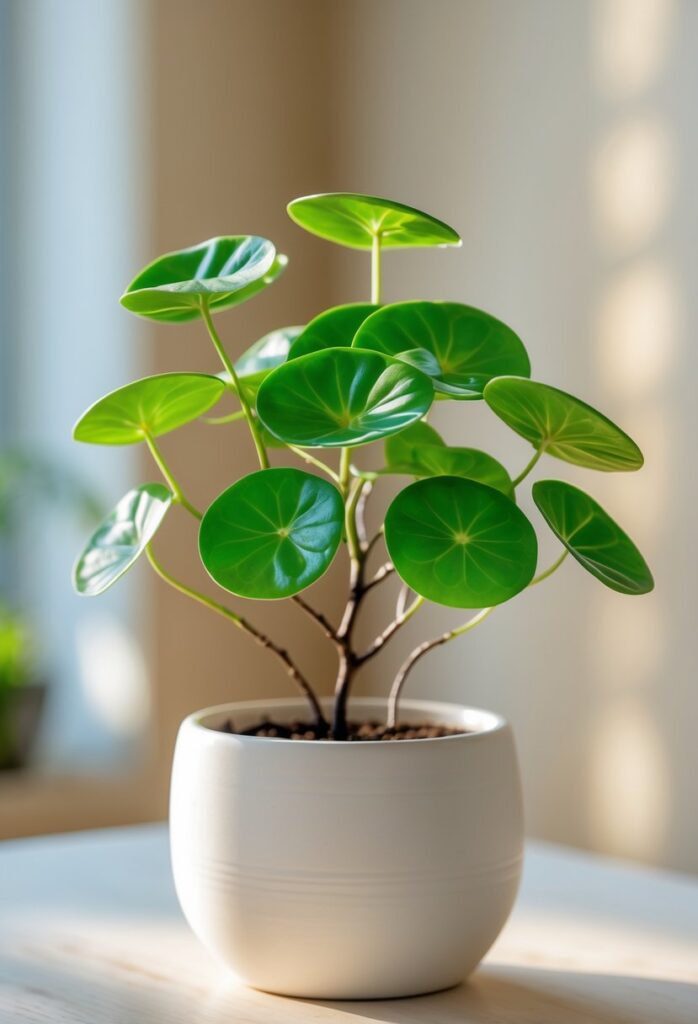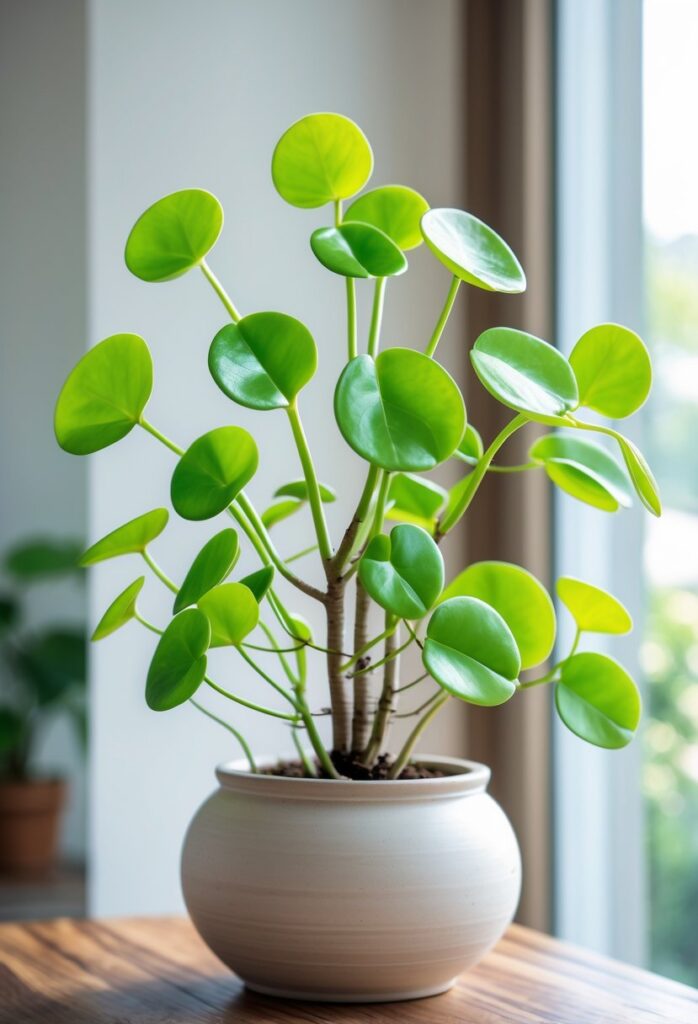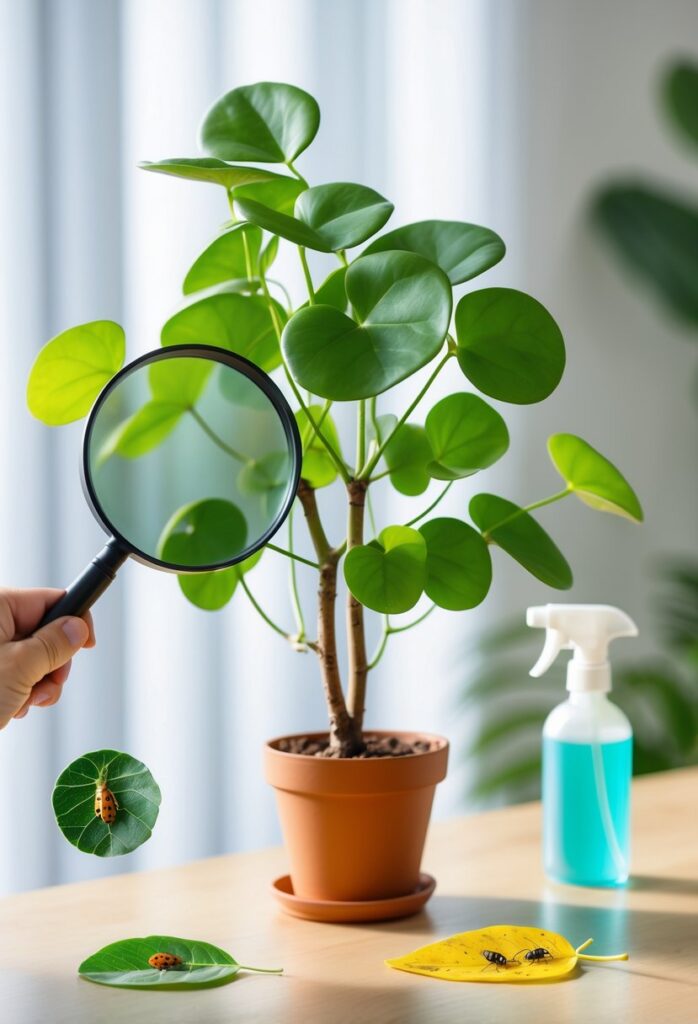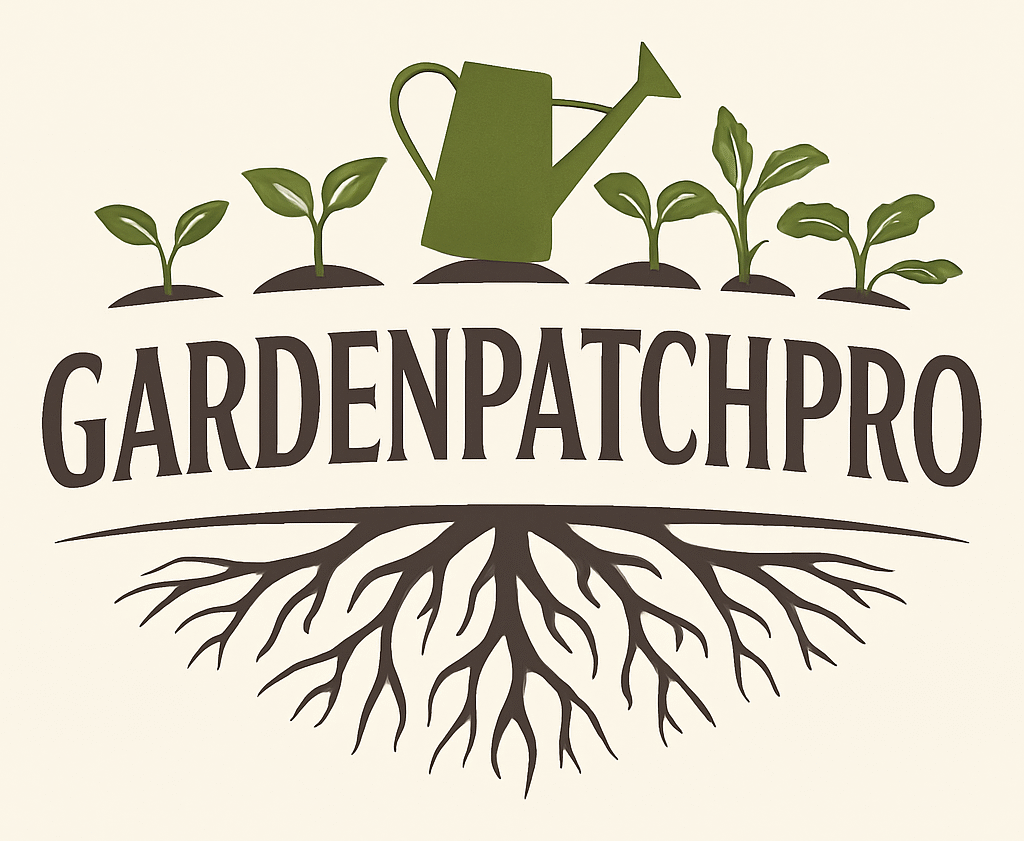Chinese Money Plant: Care, Propagation, and Essential Tips
The Chinese money plant is a popular houseplant known for its unique round, coin-shaped leaves and easy care. It thrives in bright, indirect light and prefers well-draining soil kept lightly moist, making it ideal for both beginners and experienced gardeners. Its ability to produce many offshoots also allows for simple propagation and sharing.

This plant is native to southern China, where it grows in shaded, moist forest areas. It does well in average room temperatures and doesn’t need much humidity, although it prefers moisture above 50%. Its slow but steady growth and low maintenance needs have made it a favorite in homes around the world.
Growing a Chinese money plant is simple with the right care. Understanding how to water properly, choose a suitable pot and soil, and occasionally fertilize helps keep it healthy. It is also resistant to many pests, although occasional issues can arise. For detailed care tips and the best practices, readers can explore more deeply about this charming plant.
Key Takeaways
- The Chinese money plant grows best in indirect light with moist, well-draining soil.
- It produces offshoots easily, allowing for simple propagation.
- Proper watering and occasional fertilizing support healthy growth and pest resistance.
What Is the Chinese Money Plant?

The Chinese Money Plant is a small, attractive houseplant with unique round leaves that many find appealing. It grows steadily indoors and does not require much care, making it a favorite for beginners and seasoned gardeners alike.
Botanical Classification
The Chinese Money Plant’s scientific name is Pilea peperomioides. It belongs to the nettle family, known as Urticaceae, which includes various other flowering plants. This species stands out because of its round, coin-shaped leaves that grow on long, thin stems. The stems attach to the leaf center, giving the leaves a floating look.
It is a perennial plant, meaning it lives more than two years. It usually grows 8 to 12 inches tall and wide. Unlike many nettle relatives, this plant lacks stinging hairs and is safe to keep around children and pets.
Origin and Natural Habitat
The Pilea peperomioides is native to the mountainous Yunnan Province in southern China. It grows under the shade of larger plants in cool, moist environments with well-drained soil. The plant thrives in moderate to high humidity but can adapt to typical indoor conditions.
This natural habitat gives the Chinese Money Plant its preference for bright, indirect sunlight and protection from cold drafts or direct heat. Its adaptability explains why the plant is easy to grow indoors worldwide, despite its limited natural range.
Common Names and Distinctive Features
Besides “Chinese Money Plant,” it goes by many other names, including UFO Plant, Pancake Plant, Missionary Plant, Friendship Plant, Coin Plant, Lefse Plant, and Pass-It-On Plant. These names often highlight its round leaves or its history of being shared among friends.
The leaves resemble shiny coins, growing up to 4 inches wide. They attach to long petioles at the leaf center, a trait called “peltate.” The plant rarely flowers indoors, but when it does, it produces small white to pink spike-like blooms.
Its unique look, easy care, and rich variety of nicknames make it a popular houseplant choice around the world. For more detailed information, see this guide on caring for the Chinese Money Plant.
Chinese Money Plant Care Essentials

The Chinese money plant thrives when its basic needs for light, water, and climate are met precisely. Providing the right balance helps the plant grow healthy leaves and strong roots. Attention to these key factors ensures it stays vibrant and avoids common issues like leaf drop or browning.
Light Requirements
The Chinese money plant prefers bright, indirect light. It grows best near east- or west-facing windows where sunlight is filtered. Direct sunlight can burn its delicate round leaves, causing brown spots or edges.
It can tolerate lower light levels but will grow more slowly. In dim light, the plant becomes leggy, and leaves get smaller. Rotating the plant every few weeks helps it grow evenly and stay symmetrical.
Using a grow light is a good option if natural light is limited. Avoid harsh midday sun, which will damage the foliage.
Watering Guidelines
Water the Chinese money plant only when the top inch of soil feels dry. It prefers moist but well-draining soil, so overwatering can cause root rot and leaf drop. Deep watering is best, allowing excess to drain fully.
The leaves may droop slightly when the plant needs water, offering a natural sign. Using a moisture meter can help avoid over or underwatering by checking soil dampness accurately.
Succulent or cactus potting mix works well because it drains quickly. Never let the plant sit in water, and avoid frequent shallow watering.
Humidity and Temperature Preferences
This indoor plant does well in moderate household humidity and temperatures between 60°F to 75°F (15°C to 24°C). It should be kept away from dry air sources like heaters or air conditioners.
Humidity below 40% may cause leaf edges to brown or curl. Misting occasionally or placing a humidifier nearby can help in dry environments.
The Chinese money plant is not frost hardy and should not be exposed to temperatures below 50°F (10°C). A gentle chill in winter can encourage blooming but avoid prolonged cold exposure.
Soil, Potting, and Fertilization

Chinese Money Plants need soil that drains well but holds just enough moisture. Choosing the right container and repotting at the right time helps avoid root problems. Proper fertilization feeds the plant without causing nutrient buildup or damage.
Best Potting Soil Mix
The ideal soil mix for a Chinese Money Plant combines potting soil, perlite, and organic matter like worm castings or peat moss. This mix provides good drainage and aeration while retaining moisture.
A common effective ratio is:
- 2 parts organic potting soil
- 1 part perlite
- ½ part worm castings or peat moss
Perlite keeps the soil loose and prevents waterlogging. The pH should be slightly acidic, around 6.0 to 6.5, to help nutrient uptake. Avoid heavy soils that trap water, which can cause root rot. Coconut coir can substitute peat moss for better sustainability.
Repotting and Container Selection
Repotting every 1 to 2 years prevents the soil from becoming compacted and keeps roots healthy. Choosing a pot with drainage holes is essential to avoid standing water.
A 6-8 inch pot is appropriate for most mature Chinese Money Plants. When repotting, gently loosen the root ball to encourage growth. Adding fresh well-draining soil mix helps prevent root rot and supports new roots.
If repotting isn’t possible immediately, refreshing the soil surface by mixing in perlite can improve aeration temporarily. Using pots made of breathable materials like terracotta can also help keep soil dry.
Fertilizing Techniques
Chinese Money Plants respond well to a balanced houseplant fertilizer with equal parts nitrogen, phosphorus, and potassium (like 10-10-10). Liquid houseplant fertilizer applied every 4 to 6 weeks during the growing season ensures steady nutrient supply.
Diluting fertilizer to half the recommended strength avoids overfeeding and salt buildup, which causes brown leaf tips. In winter, fertilizing can be reduced or paused because growth slows.
Applying worm castings or organic compost as a top dressing every 6 months adds gentle, natural nutrients and improves soil health. Regular feeding supports the plant’s growth and leaf development without risking fertilizer burn.
For detailed soil mixes and care, visit the guide on Chinese Money Plant Soil.
Propagation and Baby Plants

The Chinese Money Plant easily produces small baby plants called pups or offshoots. These pups can be separated and grown into new plants using a few simple methods. Successful propagation depends on recognizing healthy pups, choosing the right technique, and providing proper care to cuttings and plantlets.
Understanding Pups and Offshoots
Pups are small versions of the Chinese Money Plant that grow from the base or stem of the mother plant. There are two main types: soil pups, which emerge from the root system in the soil, and stem pups, which grow on the woody parts of the main stem.
A pup is ready to be separated when it is about 2-3 inches tall with several leaves. At this stage, it has usually developed its own roots. Separating pups too early can stunt their growth or harm the mother plant.
Recognizing healthy pups with visible roots is important for a higher chance of successful propagation. The best time to separate these offshoots is during the spring or summer growing seasons when the plant is most active.
Propagation Methods Explained
There are two main methods to propagate the Chinese Money Plant: direct-to-soil and water propagation.
- Direct-to-Soil: The pup is cut from the mother plant using a sterile knife, keeping some roots intact. It is then potted immediately in moist, well-draining soil. This method reduces transplant shock and allows the plantlet to settle quickly.
- Water Propagation: The pup is cut similarly but placed in a jar of clean water. The stem is submerged without letting the leaves get wet. Roots will grow in the water over one to two weeks, after which the plantlet is transferred to soil.
Both methods require clean tools to avoid infection. Using fresh pots and quality potting mix with good drainage supports root development and prevents rot.
Growing Plantlets and Cuttings
After separation, plantlets need stable conditions to thrive. They should be placed in bright, indirect light, avoiding direct sun that may burn their delicate leaves.
Watering should keep the soil moist but not soggy. Overwatering is a common cause of failure, often leading to root rot in young plants. It is best to let the top inch of soil dry out before watering again.
Transplant shock can cause temporary drooping or yellowing of leaves. This is normal and usually improves with time. New leaf growth appears only after the roots establish well. Patience and proper care help the new Chinese Money Plant offshoots develop into healthy, mature plants.
For more detailed guidance, see the complete guide on how to propagate Chinese Money Plant babies with foolproof methods.
Managing Pests and Common Problems

Proper care is key to keeping Chinese Money Plants healthy. Mistakes in watering, light, or pest control can cause serious issues. Paying attention to soil moisture, detecting pests early, and managing leaf health helps maintain a vibrant plant.
Preventing and Treating Root Rot
Root rot happens when soil stays too wet for too long. It causes roots to decay and leaves to yellow or drop. To prevent root rot, water only when the top 1-2 inches of soil feel dry. Use pots with drainage holes and well-draining soil.
If you spot soft stems, black or brown leaf patches, or a mushy plant base, root rot may have started. Remove the plant from its pot and trim off rotten roots. Repot it in fresh, dry soil. Cut back watering and keep the plant in bright indirect light to help it recover.
Identifying and Controlling Houseplant Pests
Common pests for Chinese Money Plants include mealybugs, spider mites, and scale insects. These pests suck sap and cause damage like white fluff, tiny webs, or sticky leaves.
Check leaves regularly, especially the undersides, for these signs. When found, gently wipe off pests with a damp cloth or use insecticidal soap. For heavy infestations, apply horticultural oil or rubbing alcohol carefully. Isolate the plant from others to prevent pest spread. Regular inspection and quick action keep pests under control.
Dealing with Leaf Drop and Growth Issues
Leaf drop can be caused by both overwatering and underwatering. Overwatering leads to soft, limp leaves, while underwatering causes dry, crispy leaves. Test soil moisture before watering. Older leaves naturally fall off as the plant grows.
Slow or no new growth often signals low light or nutrient shortage. Chinese Money Plants need bright, indirect light to thrive. If root-bound, repotting into a larger pot helps restore growth. Feeding with a balanced liquid fertilizer every 6-8 weeks during spring and summer supports leaf and stem development.
History, Uses, and Cultural Significance

The Chinese Money Plant has a rich history rooted in China’s Yunnan province and has become a popular houseplant worldwide. Its unique shape and easy care make it more than just decoration; it also holds cultural meaning and is often shared among friends.
Journey to Global Popularity
The plant, known scientifically as Pilea peperomioides, originated in the Cangshan Mountains of China. It remained mostly unknown outside China until 1946. That year, a Norwegian missionary named Agnar Espegren brought a cutting back to Norway while escaping China with his family.
From Norway, the plant spread by word of mouth and personal sharing. Gardeners nicknamed it the “Pass-It-On Plant” or “Friendship Plant” because people gave cuttings to friends instead of buying it at stores. For decades, botanists struggled to identify it until the 1980s when it was officially named.
Today, it is found in homes worldwide and admired for its round, coin-like leaves that symbolize good fortune. Its success owes much to this unique, community-driven spread rather than commercial sales.
Traditional Uses and Symbolism
The Chinese Money Plant holds a special place in Chinese culture. Its round leaves resemble coins, linking the plant to wealth, prosperity, and good luck. In Feng Shui, it is believed to attract positive energy and financial success.
People often gift this plant during housewarmings or business openings. This practice makes it a symbol of generosity and friendship, reinforcing the nicknames relating to sharing. Besides symbolism, it also improves indoor air quality slightly, adding a practical benefit.
In addition to its wealth-related meanings, the plant promotes harmony and calm. Caring for it can bring a sense of mindfulness, reducing stress, which adds to its cultural appeal.
Similar and Misidentified Species
Although called Pilea peperomioides, it is not related to the Peperomia family, despite its species name meaning “Peperomia-like.” Instead, it belongs to the nettle family (Urticaceae). This has caused some confusion since it looks similar to plants from different groups.
At one point, it was confused with plants like the “Money Tree” (Pachira aquatica), which is a separate species commonly found in stores but with different care needs and leaf shapes. Pilea’s unique flat, round leaves set it apart visually and botanically.
Understanding these differences helps buyers avoid mix-ups and ensures proper care for the Chinese Money Plant, maintaining its health and symbolic value.
Learn more about its fascinating journey and care tips in the complete Chinese Money Plant history and facts.
Frequently Asked Questions

The Chinese Money Plant needs bright, indirect light and well-draining soil to thrive. Watering should be consistent but careful to avoid root rot. Healthy growth depends on proper temperature, humidity, and occasional feeding. Propagation is simple through pups or cuttings. Pest control mainly involves managing spider mites and mealybugs.
How do I properly care for my Chinese Money Plant?
It requires bright but indirect sunlight to avoid leaf burn. The soil should dry out slightly before watering again. Regularly removing yellow or damaged leaves helps keep the plant healthy. Rotating the plant ensures even growth on all sides.
What are the best conditions for growing a healthy plant?
Temperatures between 60-75°F (15-24°C) are ideal. It prefers moderate to high humidity but tolerates average home humidity. Using a well-draining peat-based soil mix with added perlite or sand helps prevent waterlogging.
What should I do if the leaves of my plant start yellowing?
Yellowing leaves often signal overwatering or poor drainage. Check if the pot has drainage holes and reduce watering frequency. Removing affected leaves prevents further stress. Ensure the plant isn’t getting cold drafts or exposed to extreme temperatures.
How often should I water my plant?
Water when the top inch of soil feels dry, about every 7-10 days during growing seasons. In winter, reduce watering to every 2-3 weeks. Always use room temperature water and let excess water drain out to prevent root rot.
Can the Chinese Money Plant be easily propagated, and if so, how?
Yes, propagation is easy through offsets called pups. Wait until pups have their own roots before separating. Plant pups in moist, well-draining soil and keep them in indirect light. Stem cuttings can also root in water or soil and should be kept moist until established.
Are there common pests to look out for, and how can I protect my plant?
Spider mites and mealybugs are the most common pests. Increase humidity and wash leaves with water to deter spider mites. Use insecticidal soap or neem oil for severe infestations. Check for pests regularly and isolate affected plants to prevent spread.
